Articles
- Page Path
- HOME > J Korean Acad Nurs > Volume 41(6); 2011 > Article
-
Original Article
- Comparison of Standardized Peristomal Skin Care and Crusting Technique in Prevention of Peristomal Skin Problems in Ostomy Patients
- Seungmi Park, Yun Jin Lee, Doo Nam Oh, Jiyun Kim
-
Journal of Korean Academy of Nursing 2011;41(6):814-820.
DOI: https://doi.org/10.4040/jkan.2011.41.6.814
Published online: December 31, 2011
1Assistant Professor, Department of Nursing & Research Institute for Basic Science, Hoseo University, Asan, Korea.
2Wound Ostomy Continence Nurse, Nursing Department, Severance Hospital, Seoul, Korea.
3Full time Lecturer, Department of Nursing & Research Institute for Basic Science, Hoseo University, Asan, Korea.
4Assistant Professor, Department of Nursing, Kyungwon University, Seongnam, Korea.
- Address reprint requests to: Kim, Jiyun. Department of Nursing, Kyungwon University, San 65 Bokjeong-dong, Sujeong-gu, Seongnam 461-701, Korea. Tel: +82-31-750-8822, Fax: +82-31-750-8859, jkim@kyungwon.ac.kr
© 2011 Korean Society of Nursing Science
- 1,243 Views
- 13 Download
- 5 Crossref
Figure & Data
REFERENCES
Citations

- Physicochemical Properties and Composition of Peristomal Skin Care Products: A Narrative Review
Agnieszka Kulawik-Pióro, Małgorzata Miastkowska, Katarzyna Bialik-Wąs, Piotr Zelga, Anna Piotrowska
Cosmetics.2025; 12(2): 74. CrossRef - The Validity, Reliability and Usability of the Studio Alterazioni Cutanee Stomali (SACS) and Ostomy Skin Tool (OST) Instruments for Classification of Peristomal Skin Disorders
Lien Degol, Ine Olaerts, Stijn Jacobs, Gregory Sergeant, Yves Depaifve, Kristel Paque, Koen Milisen
Journal of Wound, Ostomy & Continence Nursing.2025; 52(4): 303. CrossRef - Adapted Crusting Technique in Children with Peristomal Lesions: A Case Series
Ana Cristina Santos Monteiro, Maria Lucia Barbosa Maia dos Santos, Marcia Aparecida Souza, Juliana Caires de Oliveira Achili Ferreira
Advances in Skin & Wound Care.2020; 33(6): 329. CrossRef - Scientific and Clinical Abstracts From the WOCN® Society's 49th Annual Conference
Journal of Wound, Ostomy & Continence Nursing.2017; 44(Supplement): S1. CrossRef - Scientific and Clinical Abstracts From the WOCN® Society's 45th Annual Conference
Journal of Wound, Ostomy & Continence Nursing.2013; 40(Supplement): S1. CrossRef
Procedure of Standardized Peristomal Skin Care and Crusting Technique
Sample Characteristics at the Baseline (N=81)
*Fisher's exact test.
SPSC=Standardized peristomal skin care; CT=Crusting technique.
Discoloration, Erosion, Tissue Overgrowth, and DET Total Status at 1, 2, and 3 Months
*Reference was initial skin status at the time of randomization (0 month); †Fisher's exact test; *p<.05; **p<.01.
SPSC=Standardized peristomal skin care; CT=Crusting technique, DET total status: at least one abnormal skin problem such as discoloration, erosion, and tissue overgrowth.
Comparisons between Standardized Peristomal Skin Care and Traditional Crusting Technique for the Protection of Peristomal Skin
*CT group or baseline is the reference. Controlled variables are age, gender, ostomy type, and treatment. DET total status: at least one abnormal skin problem such as discoloration, erosion, and tissue overgrowth.
Characteristics of Ostomy Care
SPSC=Standardized peristomal skin care; CT=Crusting technique; *Only patients who answer this question were analyzed (n=74, SPSC group=45, CT group=29); †Only patients who answer this question were analyzed (n=63, SPSC group=37, CT group=26); KRW=Korean Won.
*Fisher's exact test. SPSC=Standardized peristomal skin care; CT=Crusting technique.
*Reference was initial skin status at the time of randomization (0 month); †Fisher's exact test; * SPSC=Standardized peristomal skin care; CT=Crusting technique, DET total status: at least one abnormal skin problem such as discoloration, erosion, and tissue overgrowth.
*CT group or baseline is the reference. Controlled variables are age, gender, ostomy type, and treatment. DET total status: at least one abnormal skin problem such as discoloration, erosion, and tissue overgrowth.
SPSC=Standardized peristomal skin care; CT=Crusting technique; *Only patients who answer this question were analyzed (n=74, SPSC group=45, CT group=29); †Only patients who answer this question were analyzed (n=63, SPSC group=37, CT group=26); KRW=Korean Won.
 KSNS
KSNS
 E-SUBMISSION
E-SUBMISSION
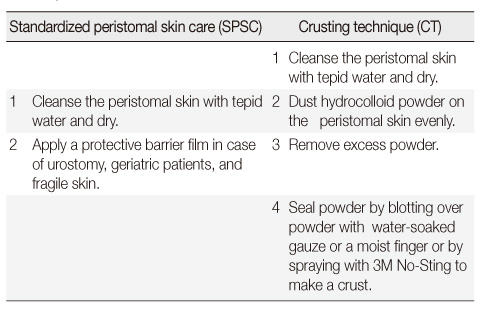
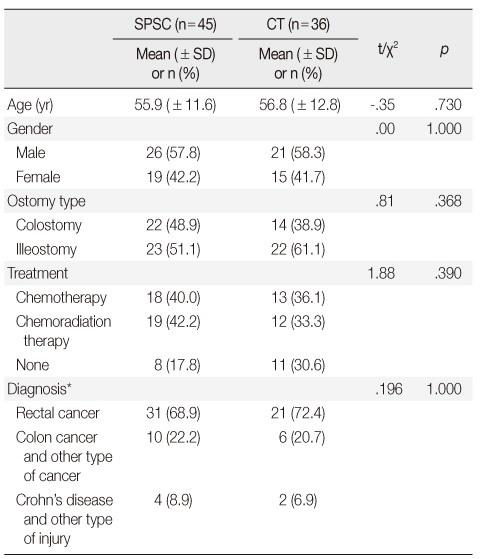
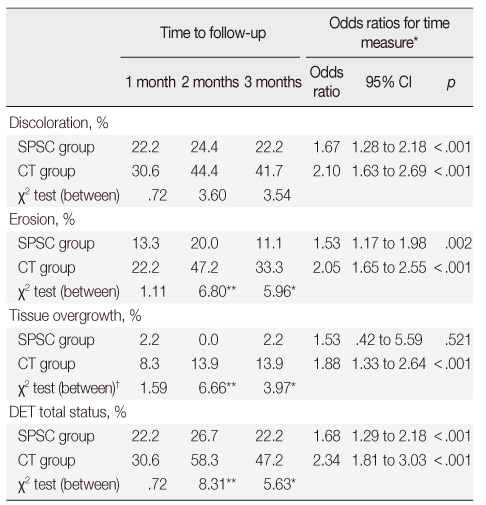
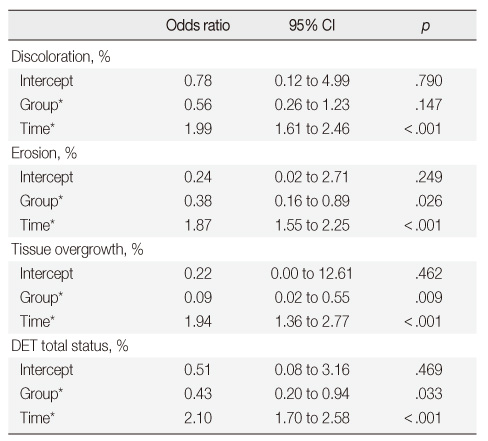
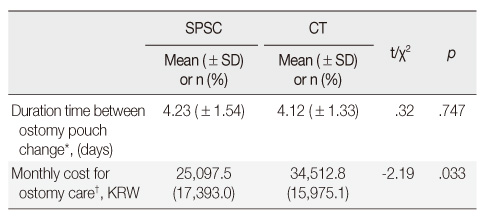
 Cite
Cite

